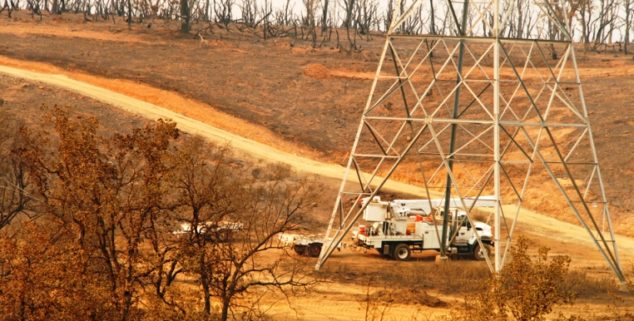News
Amid fire season, PG&E eyes its infrastructure
 A PG&E crew examines a utility poll amid the devastation of the Carr Fire last year in Redding. (Photo: Sheila Fitzgerald, via Shutterstock)
A PG&E crew examines a utility poll amid the devastation of the Carr Fire last year in Redding. (Photo: Sheila Fitzgerald, via Shutterstock) As California confronts a new fire season, the state’s largest utility says it has inspected hundreds of thousands of structures and made repairs on its sprawling infrastructure system.
In data released July 15 by Pacific Gas and Electric Co., the investor-owned utility reported there were 9,671 problems with infrastructure in areas of the state most at risk for wildfires, especially northern California.
The PG&E study was conducted as a part of the utility’s Wildfire Safety Inspection Program, which was launched after the disastrous fires in 2017 and 2018.
The report identified an array of possible wildfire hazards, ranging from decaying equipment to damage caused by woodpeckers. A majority of the problems came from aging equipment, with the highest concentration of hazards located in Sonoma, Shasta, Butte and Tuolumne counties.
The report said more than 750,000 structures were inspected throughout the most vulnerable areas, and repairs had been conducted at an accelerated rate. According to PG&E, the most pressing issues had all been either repaired, replaced or had repairs in progress. Lower priority issues were slated to be fixed within three months of their identification.
The PG&E study was conducted as a part of the utility’s Wildfire Safety Inspection Program, which was launched after the disastrous fires in 2017 and 2018. The program included more than 2,000 workers throughout PG&E’s territory, conducting on-site inspections of electric poles, transmission structures, and substations from both the ground and the air.
The program is one of many additional measures the utility said it put in place since the fires. Those include the Wildfire Safety Operations Center in 2018 and the installation of new weather stations and wildfire cameras, among other things.
Recently, Gov. Newsom signed into law a bill that requires PG&E to raise a significant portion of $10.5 billion for wildfire relief and prevention.
“We’ve accomplished a lot, but there is more work to do.” said Sumeet Singh, the vice president of the Community Wildfire Safety Program. “Our system is better today than it was yesterday, and it will be better tomorrow than it is today,” Singh said in a written statement.
PG&E has been under attack in the wake of the most recent wildfires in Northern California.
In May, state authorities determined that 2018’s Camp Fire, which burned more than 150,000 acres, destroyed nearly 19,000 structures, and caused 85 casualties, was caused by PG&E power lines. The company said that it was ‘probable’ that their equipment was responsible for the fire.
Following the fire last year, the company filed for Chapter 11 bankruptcy after they faced billions of dollars in claims for the fire. The utility had previously been found responsible by state investigators for eleven fires in 2017.
In June, the utility company agreed to pay $1 billion dollars to local governments affected by the Camp Fire, which cause $16.5 billion in damages, making it the single costliest natural disaster of 2018.
Recently, Gov. Newsom signed into law a bill that requires PG&E to raise a significant portion of $10.5 billion for wildfire relief and prevention. In a statement on July 25, PG&E said that its initial contribution to the wildfire fund would be $4.8 billion, with annual contributions of about $193 million. PG&E is only required to pay this sum after it emerges from bankruptcy.
“California’s ever-growing risk of wildfire is a reality we must face squarely, and a matter of deep concern to all of us who call this place home…We will continue to work with the Governor, the Legislature, the California Public Utilities Commission, and all other stakeholders in finding shared solutions to our common challenges without creating more costs for our customers,” Bill Johnson, PG&E’s president and CEO, said in the release.
—
Editor’s Note: Joaquin Romero is a Capitol Weekly intern from UC Riverside.
Want to see more stories like this? Sign up for The Roundup, the free daily newsletter about California politics from the editors of Capitol Weekly. Stay up to date on the news you need to know.
Sign up below, then look for a confirmation email in your inbox.

Leave a Reply